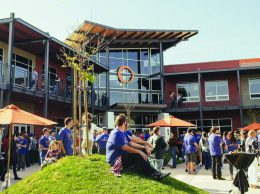Central Coast leads the way as solar, tourism boost SLO County recovery
IN THIS ARTICLE
- Central Coast Topic
- Staff Report Author
By Staff Report Friday, November 22nd, 2013

The 550-megawatt Topaz Solar Farm stretches across San Luis Obispo County’s Carrizo Plain. At full build-out, it will have about 8.5 million photovoltaic panels and 1,170 miles of underground cable. (Stephen Nellis / Business Times file photo)
Job growth in San Luis Obispo County outpaced most of California during the past year, putting the county in an elite class of communities that have replaced all the jobs they lost in the recession.
In remarks prepared for the 2014 SLO County Economic Forecast Breakfast on Nov. 22, Jordan Levine of Beacon Economics said only San Luis Obispo, San Jose, San Francisco and Bakersfield have gone positive when it comes to the pre-recession jobs peak.
“San Luis Obispo is a shining star on the Central Coast,” he said, adding that the area can expect job growth of 1.5 to 2.5 percent per year going forward. “It’s a pretty broad-based jobs recovery,” he said. “San Luis Obispo is adjusting to the new normal.”
SLO County was hard hit during the recession as real estate activity came to a standstill. But the county’s construction recovery got a jump start as two utility-scale solar energy projects each added hundreds of temporary jobs to the region.
With the massive Topaz Solar Farm project headed for a wind-down in jobs next year, Levine said growth in tourism, manufacturing, retail activity and professional services will kick in. “Growth is going to be pretty solid,” he said.
Although it is the smallest of the three Tri-Counties with a population of about 250,000, SLO County’s solid recovery has buoyed the regional economy’s tourism and technology clusters. Recent construction activity in the area around San Luis Obispo’s airport, including a new headquarters for software firm MindBody, have stimulated jobs in both the construction and tech sectors.
The recovery also has helped stabilize the region’s banking sector, which was hard hit by write downs on commercial loans and residential foreclosures when the economy faltered after the 2008 financial crisis.
Rebounding tourism has generated millions of dollars in hotel and retail sales taxes for local governments helping fill coffers that were depleted when the recession hit and falling property prices cut into real estate tax revenue.












